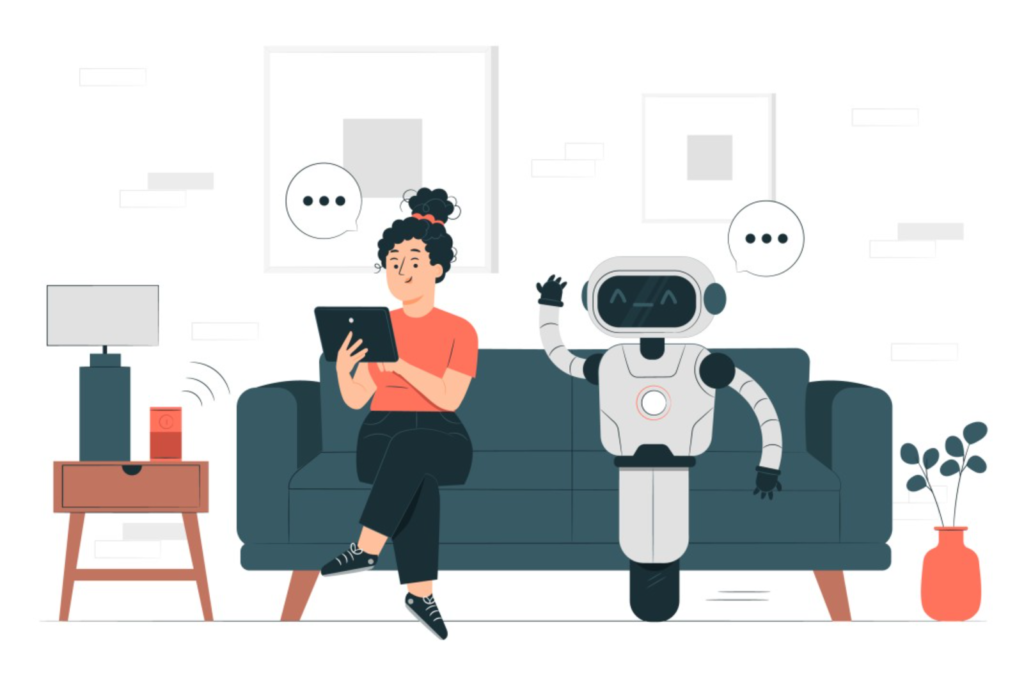In today’s world, Conversational Artificial Intelligence (AI) is like having a chat with a robot that understands you. It’s a bit like talking to a friend who can help you with various tasks, from finding information online to controlling smart gadgets in your home. Let’s explore the main technologies that make this possible, explained in simple terms.
Natural Language Processing (NLP)
Natural Language Processing (NLP) serves as the linguistic bridge between humans and computers. Imagine composing a letter to a mate in another country who speaks a different language. NLP acts as the translator, facilitating mutual comprehension between computers and humans. It empowers computers to grasp the intricacies and subtleties of our language, allowing seamless communication. In essence, NLP enables us to interact with computers in a manner similar to our interactions with fellow humans, accommodating the quirks and nuances inherent in language.
Machine Learning & Deep Learning
Machine learning is like teaching a computer to become smarter over time by learning from its experiences. It’s similar to how you learn to ride a bike; you fall, get up, and try again until you can ride without falling. Computers, through machine learning, improve at tasks by learning from data, not from direct programming. Deep learning goes a step further, allowing computers to learn from vast amounts of data, much like how our brains process information from our senses.
Speech Recognition
Have you ever used Siri, Alexa, or Google to ask for the weather or play your favourite song? That’s speech recognition at work. It’s the technology that helps computers understand when we talk to them. Just as you recognise your friend’s voice and understand what they’re saying, speech recognition enables computers to do the same with our voices.
Applications of Conversational AI
Customer Service and Support
The advent of Conversational AI has revolutionised customer service by introducing chatbots and voice assistants capable of handling inquiries round the clock. These AI-driven solutions can manage a multitude of customer interactions simultaneously, from answering FAQs to resolving complex issues, significantly reducing wait times and enhancing customer satisfaction. By automating routine inquiries, businesses can allocate human resources to more critical tasks, thereby improving operational efficiency.
E-commerce and Retail
In the e-commerce and retail sectors, Conversational AI serves as a personal shopping assistant, guiding customers through their purchasing journey. From providing product recommendations based on user preferences to answering queries and facilitating transactions, AI-powered conversational agents enhance the shopping experience, making it more engaging and personalised. This not only aids in customer retention but also drives sales by offering targeted suggestions and streamlined checkout processes.
Healthcare
Conversational AI is making strides in healthcare by offering virtual health assistants that provide medical information, medication reminders, and symptom triage before doctor visits. These applications improve patient engagement, offering 24/7 support and accessibility, which is particularly beneficial in remote areas or for individuals with mobility challenges. Moreover, AI-driven platforms can gather patient data, aiding in personalised care plans and improving treatment outcomes.
Banking and Finance
The banking and finance industry benefits from Conversational AI through enhanced customer service, transaction assistance, and personalised financial advice. AI chatbots can handle a wide range of tasks, from account inquiries to facilitating payments, and even offering insights on spending habits. This not only improves customer experience but also bolsters security by employing advanced algorithms to detect and prevent fraudulent activities.
Education and Learning
Conversational AI is transforming the education sector by providing personalised tutoring, answering student queries, and facilitating language learning. These AI tutors adapt to individual learning styles and paces, offering tailored feedback and support. This approach not only makes education more accessible but also encourages a more engaging and interactive learning experience.
Human Resources
In human resources, Conversational AI streamlines the recruitment process, automates initial screenings, and schedules interviews, significantly reducing the time and resources spent on these tasks. Additionally, it can assist with onboarding, answering FAQs about job roles, and managing routine HR inquiries, thereby enhancing the employee experience and freeing up HR professionals to focus on strategic initiatives.
Travel and Hospitality
Travel bots powered by Conversational AI assist users in booking flights, accommodations, and even offering personalised travel advice. These bots can process user preferences to provide tailored recommendations, making travel planning more efficient and enjoyable. Moreover, AI-driven conversational agents enhance customer service by providing instant assistance and information, elevating the overall travel experience.
Entertainment and Media
In the entertainment and media industry, Conversational AI is used to provide personalised content recommendations, facilitate content discovery, and engage users in interactive experiences. By analysing user preferences, AI can curate content suggestions, enhancing user engagement and satisfaction. Additionally, conversational news apps offer a novel way to consume news, allowing users to interact with the content in a more engaging manner.

Conversational AI is like having a friend who’s always there to help you, whether it’s finding information, learning something new, or just making your day a bit easier. By combining the power of language understanding, learning from experiences, and recognising speech, this technology is making our interactions with machines more natural and human-like. So, the next time you talk to a voice assistant or chat with a customer service bot, remember the incredible technologies working behind the scenes to make that conversation possible.

